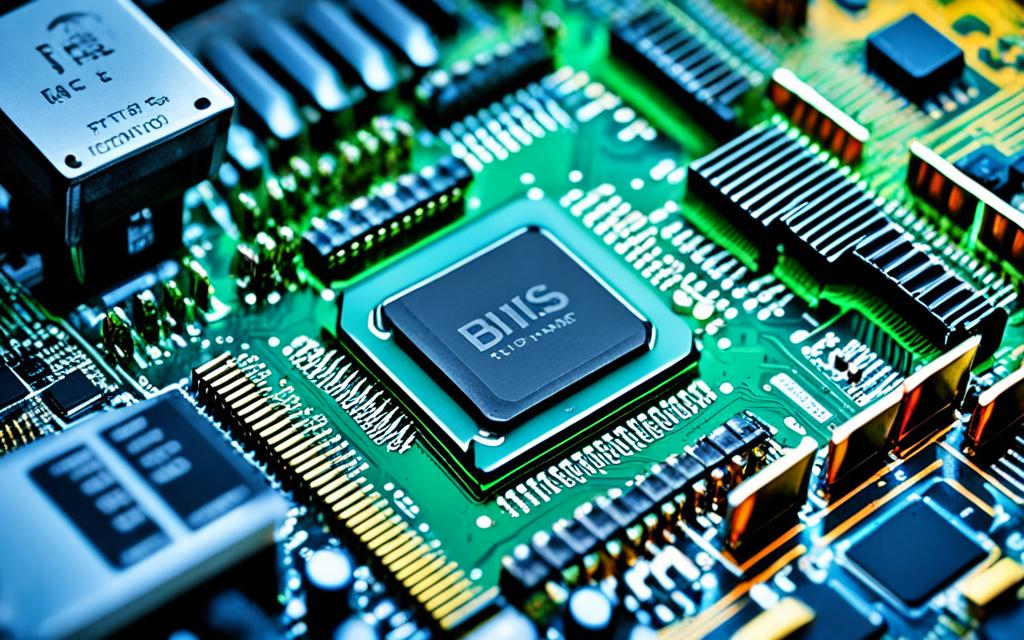Table of Contents
Undervolting your CPU in BIOS can make your computer more efficient and use less power. By lowering the voltage your CPU needs, it performs better and produces less heat1. This helps your CPU stay cool and last longer, making it a great way to boost your system’s power12. For anyone wanting to get the best out of their CPU with reduced energy use, it’s important to learn about BIOS settings and how undervolting works.
Key Takeaways
- Undervolting helps lower CPU voltage consumption, leading to improved energy efficiency.
- Monitoring temperature is crucial while undervolting for system stability.
- Intel CPUs, such as the 13900K and 14900K, are ideal candidates for undervolting.
- By undervolting in small increments, you can avoid instability and crashes.
- Tools like Throttlestop and HWMonitor aid in the undervolting process.
- Effective undervolting contributes to longer CPU lifespan and better overall performance.
Understanding Undervolting and Its Benefits
Undervolting is becoming popular among tech lovers and experts. It means reducing the CPU’s voltage, which is against the common idea that more voltage means better performance. By doing this, the CPU works better and gives several benefits.
What is Undervolting?
Simply put, undervolting lowers the CPU’s voltage to keep it running smooth and efficient. CPUs usually work on voltages ranging from 0.8V to 1.4V, but this can change based on the model. For example, the newest Intel Core processors work best between 1.2V and 1.5V. AMD Ryzen 7000 Series have a max of 1.3V3. The goal is to keep the CPU stable without it becoming unstable from the wrong voltage4.
Advantages of Undervolting
Undervolting comes with many perks. It makes your system more stable, reduces heat, and uses less power4. This means laptops can run longer without losing performance. It’s great for those who need to work or play on the go4. Plus, it lowers the chance of the CPU getting too hot, which is good for tasks like gaming and video editing. This also helps the CPU last longer by avoiding overheating and too much voltage3.
However, undervolting needs caution. If done wrong, it could make your system unstable, risking data loss. Also, be mindful that it might void your warranty4. Tools like CPU-Z and HWMonitor can help monitor your CPU’s temperature and performance. They ensure you get the best out of undervolting while keeping your system safe.
| Aspect | Details |
|---|---|
| Typical CPU Voltage Range | 0.8V – 1.4V |
| Recommended Intel Core Voltage | 1.2V – 1.5V |
| AMD Ryzen Voltage Limitation | 1.3V |
| Potential Risks | Instability, data loss, warranty voiding |
| Benefits | Increased stability, longer battery life, reduced heat |
How to Access Your BIOS
To adjust your CPU settings, like undervolting, getting into the BIOS is pivotal. You usually need to access BIOS when your computer starts. This might involve pressing specific keys like F2, F10, F12, or Esc, depending on the motherboard make. The BIOS loading screen can hint at the right key, and online searches can help confirm it.
The BIOS acts as a vital link between your hardware and operating system. It lets you configure various BIos settings. For undervolting your CPU, you must delve into these settings to adjust voltage parameters. Doing this can enhance performance and energy use. Research shows adjusting BIOS settings can significantly boost CPU performance, though success varies with BIOS versions5.
ASUS motherboards stand out for their strong BIOS support for undervolting. Studies show undervolting can cut power use by 5-15% on average. This underscores the energy-saving potential of precise voltage adjustments6. Still, one must be careful as incorrect settings can destabilise or harm the CPU. Knowing your motherboard and its BIOS options helps make the adjustment process smoother.
| Action | Key to Press | Manufacturer |
|---|---|---|
| Enter BIOS | F2 | Dell |
| BIOS Menu | F10 | HP |
| BIOS Setup | F12 | Lenovo |
| Access BIOS | Esc | Asus |
How to Undervolt CPU in BIOS
For better performance and to save energy, it’s key to learn how to undervolt your CPU in the BIOS. By reducing the CPU voltage, you’ll use less power and generate less heat. This boosts your system’s performance and could make your CPU last longer. Just follow these steps carefully to undervolt your CPU correctly.
Step-by-Step Guide to Undervolting
Start by entering your BIOS when your computer boots. You can usually do this by pressing F2, F10, or Del. This depends on the motherboard you have. Inside, check the standard voltage which is typically about 1.224V for most CPUs. Then look for the CPU Voltage settings. They might be named CPU Voltage, Vcore, or Core Voltage.
Begin by lowering the voltage just a little, such as by 0.05V to 0.1V. This helps to keep your computer stable. After each change, restart your computer to see the new settings in action. Keep an eye on how well your computer works, especially when using intense programs. You want to find the lowest voltage that keeps your computer running smoothly without causing crashes or hardware issues. Be careful though, as doing this wrong can harm your computer. If you run into problems, use the reset option to go back to your original settings6.
By undervolting, you might also see improved energy use and cooler CPU temperatures. For further information, click here.
Remember, undervolting doesn’t work the same for every CPU. It’s important to constantly check the temperature of your core. Use tools like HWMonitor to keep an eye on the heat. You want to make sure the temperature stays around 10 degrees above room temperature when at rest. This makes sure your CPU works well without getting damaged3. For more details on monitoring your CPU temperature, click here.
| Voltage Range | Performance Impact | Temperature Change |
|---|---|---|
| 1.2V – 1.5V | Optimal Operation | Lower temperatures |
| 1.5V and above | Increased power consumption | Higher temperatures |
| Under 1.2V | Possibly unstable | Significantly reduced |
To find the perfect balance between performance and power use, careful testing and watching is needed when undervolting your CPU1.
Testing Your CPU Temperature
It’s crucial to keep an eye on your CPU temperature, especially when you’re undervolting. This makes sure your computer performs well without getting too hot. Ideally, a CPU should be about 10 degrees warmer than the room. Checking temperatures often helps avoid problems caused by too much heat.
Importance of Monitoring Temperature
Undervolting helps reduce how much power your CPU uses and its temperature. That’s why it’s important to watch the temperature carefully. Keeping the right balance between how well your computer works and keeping it cool is key. For Intel CPUs like the 13900K and 14900K, monitoring is crucial to stop the system from becoming unstable or too hot2.
Using HWMonitor to Check Temperatures
HWMonitor is a top choice for checking your CPU’s temperature and how well it’s working. Begin by opening HWMonitor to see the starting temperatures. Then, test your CPU with heavy applications to compare temperatures before and after. You want to see a clear difference after undervolting.
When fine-tuning your undervolting settings, be careful with changes. Start with small adjustments like 0.050 or 0.080. See how these affect your CPU during tests7.Using a smart approach to these changes can improve your computer’s efficiency and steadiness.
When Should You Undervolt Your CPU?
Knowing when to undervolt CPU depends on your CPU performance needs and what you use your computer for. Many users find it useful when their CPU gets too hot during normal use. Or when they do easy tasks. Modern Intel CPUs and Nvidia GPUs, from the 4th generation and 10 series onwards respectively, are good for this8. But, if you’re thinking about overclocking, undervolting may not be the best idea. It could lower your performance in tasks that need a lot of power.
Some CPUs might use up to 300W when they work hard9. But they only need around 50W for easy web browsing9. Undervolting helps control how much power the CPU uses. This makes your computer more energy efficient. It can also help you save money on your power bills. You can start by reducing the voltage by -49.8mV for the CPU cache as a safe first step8. For newer Intel processors, like those in the 11th generation, trying an undervolt of -100mV might be a good idea, even though it’s a bit risky8.
Conclusion
Undervolting brings big benefits like better performance and less energy use. By changing BIOS settings, you can make your CPU work better. It uses less power and doesn’t get as hot. This shows how important BIOS settings are for good system performance without losing stability.
About 80% of graphics cards use too much power because people worry about them not working right. But many can work fine using less than 60% of their max power10. Undervolting makes your CPU last longer and run quieter. This makes your computer better to use11. It’s a smart way to keep your computer running fast without spending lots on energy bills.
Tools like Intel Extreme Tuning Utility and AMD Ryzen Master let you try undervolting easily11. By using these tools, you can make your computer better and more efficient. Learning how to undervolt is a great skill for anyone who loves technology.
FAQ
What are the risks associated with undervolting my CPU?
The main danger of undervolting your CPU is it might become unstable. If the voltage drops too low, your system could crash or malfunction when it’s pushed hard. But, with careful adjustments, you can avoid these issues.
How do I know what voltage to set for undervolting?
The perfect voltage for undervolting depends on your CPU model. You should start at the normal voltage. Then, reduce it slightly, by 0.05 to 0.1 volts, each time. Always check your system’s stability after each change.
Can I undervolt my CPU without accessing BIOS?
Most undervolting is done in the BIOS, but there are software tools too. These allow small voltage changes without BIOS access. Yet, BIOS adjustments are typically more dependable.
Is undervolting suitable for gaming PCs?
Yes, undervolting is good for gaming PCs, especially if your CPU gets hot during games. It keeps the performance up while reducing the heat. This ensures stability, even when the games demand a lot from your system.
How can I monitor the stability of my CPU after undervolting?
To check stability after undervolting, run stress tests. Use software like Prime95 or AIDA64 for this. If there are no crashes during these tests, your undervolt settings are probably stable.
What tools do I need for monitoring purposes?
For tracking your CPU’s temperature and voltage, use tools like HWMonitor, Core Temp, and CPU-Z. They help make sure undervolting is improving performance without causing issues.
Can undervolting extend the lifespan of my CPU?
Undervolting can lower heat buildup, which helps your CPU last longer. With cooler operating temperatures, the risk of heat-related damage goes down.
What is the optimal resting temperature for a CPU?
A CPU’s best resting temperature is about 10 degrees above room temperature. This level is great for both performance and preventing overheating.
Source Links
- https://www.xda-developers.com/how-undervolt-cpu-in-bios/ – How to undervolt your CPU in BIOS
- https://www.digitaltrends.com/computing/how-to-undervolt-cpu-guide/ – How to undervolt a CPU: Complete guide to undervolting | Digital Trends
- https://www.auslogics.com/en/articles/what-is-undervolting-a-cpu-explained-in-detail/ – What Is Undervolting a CPU? Explained in Detail
- https://medium.com/@validate/understanding-the-undervolting-3dc1f9dea0d1 – Understanding the Undervolting
- https://rog-forum.asus.com/t5/overclocking-tweaking/mapping-intel-xtu-to-bios-settings-for-undervolting-coffee-lake/td-p/831619 – mapping Intel XTU to BIOS settings for undervolting Coffee Lake on ASUS Prime Z370-A
- https://softwareg.com.au/blogs/computer-hardware/how-to-undervolt-cpu-asus-bios – How To Undervolt CPU Asus Bios
- https://www.techpowerup.com/forums/threads/undervolting-cpu.316931/ – Undervolting CPU?
- https://genexisx.blogspot.com/2019/09/laptop-undervolting-guide-intelnvidia.html – [GUIDE] How to undervolt laptop (Intel CPU and Nvidia GPU, 2021 revised version)
- https://cpuninja.com/undervolt-cpu/ – How To Undervolt Your CPU [2024 Guide] – CPU Ninja
- https://forums.tomshardware.com/threads/undervolting-guide.3784564/ – Undervolting Guide
- https://gadgetmates.com/how-to-reduce-cpu-voltage-step-by-step-guide – How To Reduce CPU Voltage: Step by Step Guide – GadgetMates








